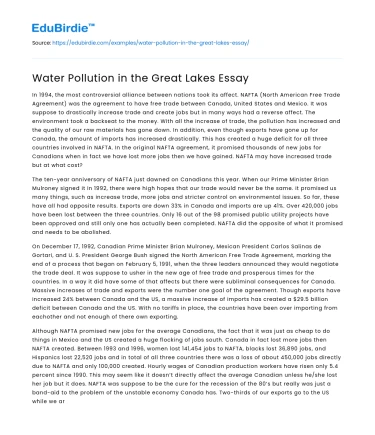In 1994, the most controversial alliance between nations took its affect. NAFTA (North American Free Trade Agreement) was the agreement to have free trade between Canada, United States and Mexico. It was suppose to drastically increase trade and create jobs but in many ways had a reverse affect. The environment took a backseat to the money. With all the increase of trade, the pollution has increased and the quality of our raw materials has gone down. In addition, even though exports have gone up for Canada, the amount of imports has increased drastically. This has created a huge deficit for all three countries involved in NAFTA. In the original NAFTA agreement, it promised thousands of new jobs for Canadians when in fact we have lost more jobs then we have gained. NAFTA may have increased trade but at what cost?
The ten-year anniversary of NAFTA just dawned on Canadians this year. When our Prime Minister Brian Mulroney signed it in 1992, there were high hopes that our trade would never be the same. It promised us many things, such as increase trade, more jobs and stricter control on environmental issues. So far, these have all had opposite results. Exports are down 33% in Canada and imports are up 41%. Over 420,000 jobs have been lost between the three countries. Only 16 out of the 98 promised public utility projects have been approved and still only one has actually been completed. NAFTA did the opposite of what it promised and needs to be abolished.
Save your time!
We can take care of your essay
- Proper editing and formatting
- Free revision, title page, and bibliography
- Flexible prices and money-back guarantee
On December 17, 1992, Canadian Prime Minister Brian Mulroney, Mexican President Carlos Salinas de Gortari, and U. S. President George Bush signed the North American Free Trade Agreement, marking the end of a process that began on February 5, 1991, when the three leaders announced they would negotiate the trade deal. It was suppose to usher in the new age of free trade and prosperous times for the countries. In a way it did have some of that affects but there were subliminal consequences for Canada. Massive increases of trade and exports were the number one goal of the agreement. Though exports have increased 24% between Canada and the US, a massive increase of imports has created a $29.5 billion deficit between Canada and the US. With no tariffs in place, the countries have been over importing from eachother and not enough of there own exporting.
Although NAFTA promised new jobs for the average Canadians, the fact that it was just as cheap to do things in Mexico and the US created a huge flocking of jobs south. Canada in fact lost more jobs then NAFTA created. Between 1993 and 1996, women lost 141,454 jobs to NAFTA, blacks lost 36,890 jobs, and Hispanics lost 22,520 jobs and in total of all three countries there was a loss of about 450,000 jobs directly due to NAFTA and only 100,000 created. Hourly wages of Canadian production workers have risen only 5.4 percent since 1990. This may seem like it doesn’t directly affect the average Canadian unless he/she lost her job but it does. NAFTA was suppose to be the cure for the recession of the 80’s but really was just a band-aid to the problem of the unstable economy Canada has. Two-thirds of our exports go to the US while we are still the weakest link in NAFTA only contributing 8 % of the increase in the total GDP
Another topic that somehow dropped off the media's radar was NAFTA's impact on the environment. In NAFTA's wake, fewer than 1 percent of trucks entering the U.S. each year are inspected even though 50 percent of those inspected are rejected for major safety and environmental violations. Forty percent of the Mexican population in the border area have no sewers or drinkable water, likewise some 400,000 people on the U.S. side. How does this all affect Canada? The quality and price of these products we get are from these environment and poverty challenged places are affected. The air we breathe in is being diluted because of this sudden increase of trade. The Great Lakes have increased levels of toxic elements while the increase of trucks crossing the US-Canada border has.






 Stuck on your essay?
Stuck on your essay?

